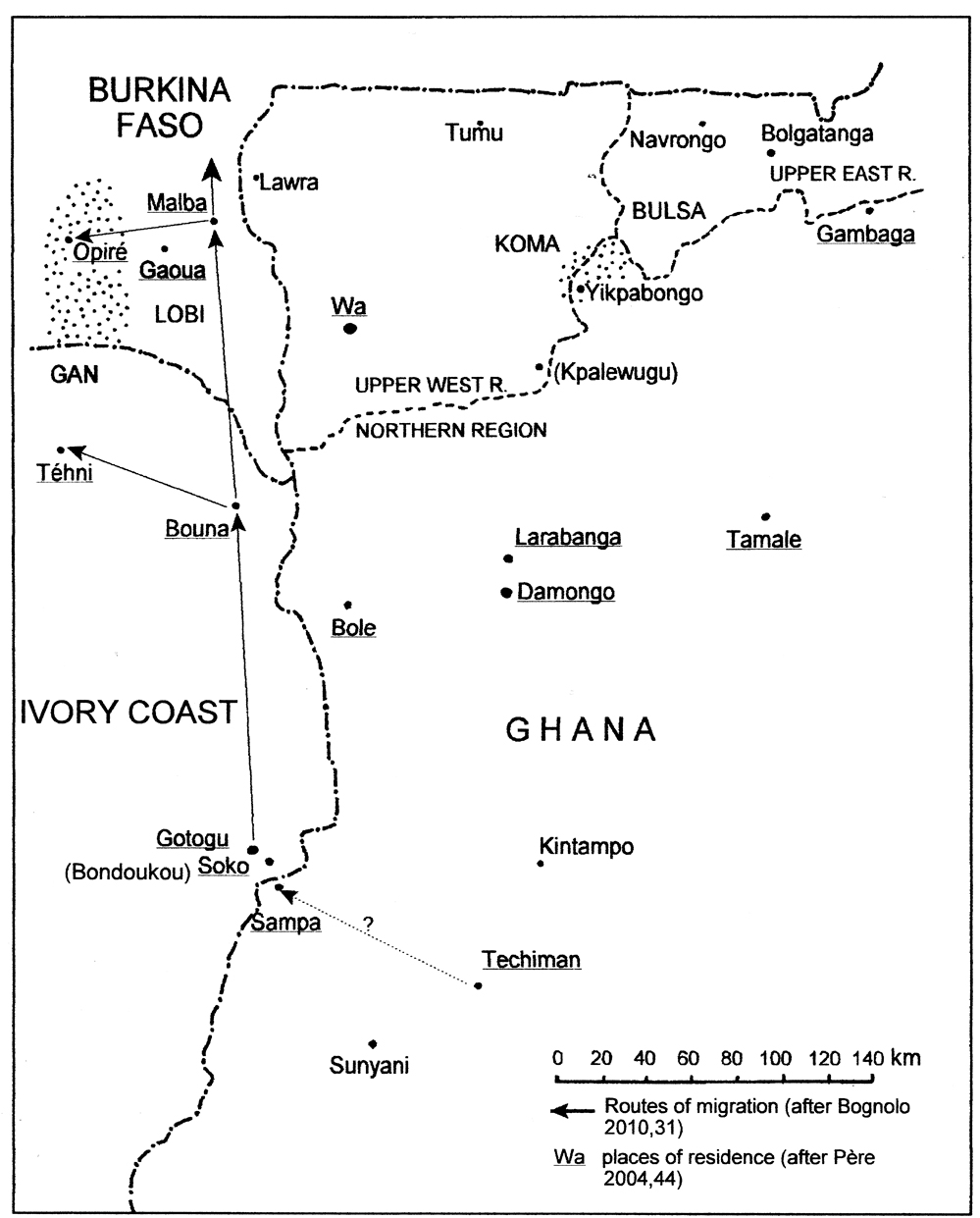This influence of the Kantonsi on the former residents of the excavation area does not mean that Wilks holds the Kantonsi to be the creators of the terracottas, for in an endnote he comments, "‘Komaland’ represents, of course, the invention of another mythical society" (1989:215). Although it is quite possible that Kantonsi traders frequented Komaland, I also exclude such authorship because, during the heyday of terracotta production, these people whom Wilks calls "Old Muslims" had already accepted the Islamic faith. As it appears from the pictures in my photo collection of more than 4,000 Komaland terracottas, the producers of the largely unclothed figurines demonstrate free treatment of sexual themes: women are depicted with their vaginas wide-open, the genitals of men are mostly uncovered and there are phallic figurines belonging to the repertoire of the artists. All of this would be contrary to the religious and moral ideas of the Islamic Kantonsi. This does not rule out that some similarities between the two cultures may have come about by, for example, commercial contact. According to Zakari (2010:70), Kankpeyeng, in his unpublished PhD dissertation (2003), mentions some correlations between Kpaliworgu (Palewogo) and Komaland pottery. As concerns the question of the cultural creators of the Komaland terracottas, the suggestions of the archaeologists Anquandah, Kankpeyeng and Insoll as well as my own hypothesis, prompted by Klaus Schneider and Madeleine Père (2004), appear to be more likely.
3. The Bulsa (Upper East Region of Ghana)
Agbandem, an elder of the Bulsa village of Wiaga-Tandem-Zamsa who had shown me two terracotta heads in an earth shrine consisting of a pile of stones was probably the first to associate the makers of the later-named Komaland terracottas with the autochthonic Bulsa (cf. Kröger 1982:17 and 1988:133). To support his statement, the elder referred to the headdress on one terracotta head and interpreted it as a calabash helmet studded with cowries, an accoutrement still worn by the Bulsa today. Agbandem even claimed that the two figurines were representations of the original ancestors of all indigenous Bulsa.
Along with the aforementioned calabash helmets, other items like knobbed ceramic pots, jewellery and amulets (for example crescent chest pendants, foot and arm bangles with round cross sections and metal leg cuffs) represent the most significant corresponding cultural parallels between the Bulsa and Komaland objects.
While in his first publications Anquandah does not tackle the question of cultural authorship, his publication in 1998 represents a detailed enumeration of material elements as they appear in Komaland and Bulsa culture. He even uses Bulsa names for objects of material culture found on the excavated figurines, for example:
• julung: triangle-shaped cloth worn as underwear (1998:45)
• chiik: crescent pendant (1998:63)
• lig-pieli: cowrie (1998:160, 169)
• zuk chin: calabash helmet (1998:163–164)
• goa zuk chin: calabash helmet (1998:43)
• nientik: double spiral amulet which is worn on a waist string in Anquandah's drawing as well as by Bulsa children of today (1998:44, Fig. 4.1)
• bang(sa): different types of bracelets (1998:43–44): nying bang (metal bracelet), kampiung (stone bracelet), sigain (ivory bracelet), poali (leather bracelet), jinka (straw bracelet; more common: jek) and chakesa (metal leg cuffs)
Some of Anquandah's explanations may be called into question. In numerous
interpretations of non-anthropomorphic terracotta objects, he tries to
demonstrate that a certain object occurs or occurred in both the Bulsa as well
as in the old Komaland culture. Criticism may be primarily directed to the fact
that, in this case, isolated material elements of Komaland terracottas are
chosen as starting points for interpretations. It would be more appropriate, in
my opinion, to consider these phenomena as part of a long series of examples of
one type, including all variations that have occurred. In Anquandah's book, for
example, the photos of four objects that both Kankpeyeng, Insoll and I would
refer to as double cones or bi-cones, are depicted (1998:150, Fig. 7.24).
Anquandah refutes the interpretation of other archaeologists who call the
objects bellows and instead designates them as double bells (1998:159).
Admittedly, some of the double cones show a certain resemblance to the iron
double bells of the Bulsa and many other ethnic groups of Africa. However,
considering the extent of the variations in the form of the double cones, some
of the specimens do not evoke any association with double bells. In addition,
the objects depicted with their sacrificial bowls (the open parts of the bells)
and the conical lower parts (which were probably stuck into the ground or a
mud-shrine) seem rather to fit into the category of other terracottas (i.e.
single cones, heads or bodies with conical lower parts), which can be
interpreted as small shrines or "sacrificial bowls" that may have been part of
larger shrines.
The situation is similar with other interpretations that are expected to
demonstrate a relationship of terracotta elements with the Bulsa material
culture. On page 169 (Fig. 9.7) of the above-mentioned publication, eight
different "amulet necklace motifs" are depicted, including one which Anquandah
calls a "star" (chingmarik). Not only does the object resemble a
five-pointed star to some extent, but it also coincides with the occurrence of
star amulets worn as necklaces among the Bulsa today. These factors favour
Anquandah’s interpretation. However, if we consider the shape within the full
repertoire of Komaland terracottas, numerous variations of this type have no
resemblance to a star. In Fig. 9.7 of Anquandah’s text, for example, the design
shown below the above-mentioned amulet represents the same basic elements, but
in fact has hardly any resemblance to a star. Rather, it strongly resembles the
forms shown on the same page that are referred to as "moons" (chiik).
More substantial arguments supporting the suggestion that the Bulsa are culturally related to the creators of the terracottas can be derived from the metal artefacts excavated in Yikpabongo by Anquandah. All types mentioned here are still worn or used today:
• Bang-gbin: a twisted iron bangle with loops
• Bangmieni: a twisted bronze bangle
• Poning: an iron knife or razor
• Ni-felin: an iron finger-ring
• Nientik: a small iron amulet with two spirals
• Chiik: a moon-shaped iron amulet worn as a necklace pendant (Anquandah 1998:42–43)
4. The Lobi (Burkina Faso)
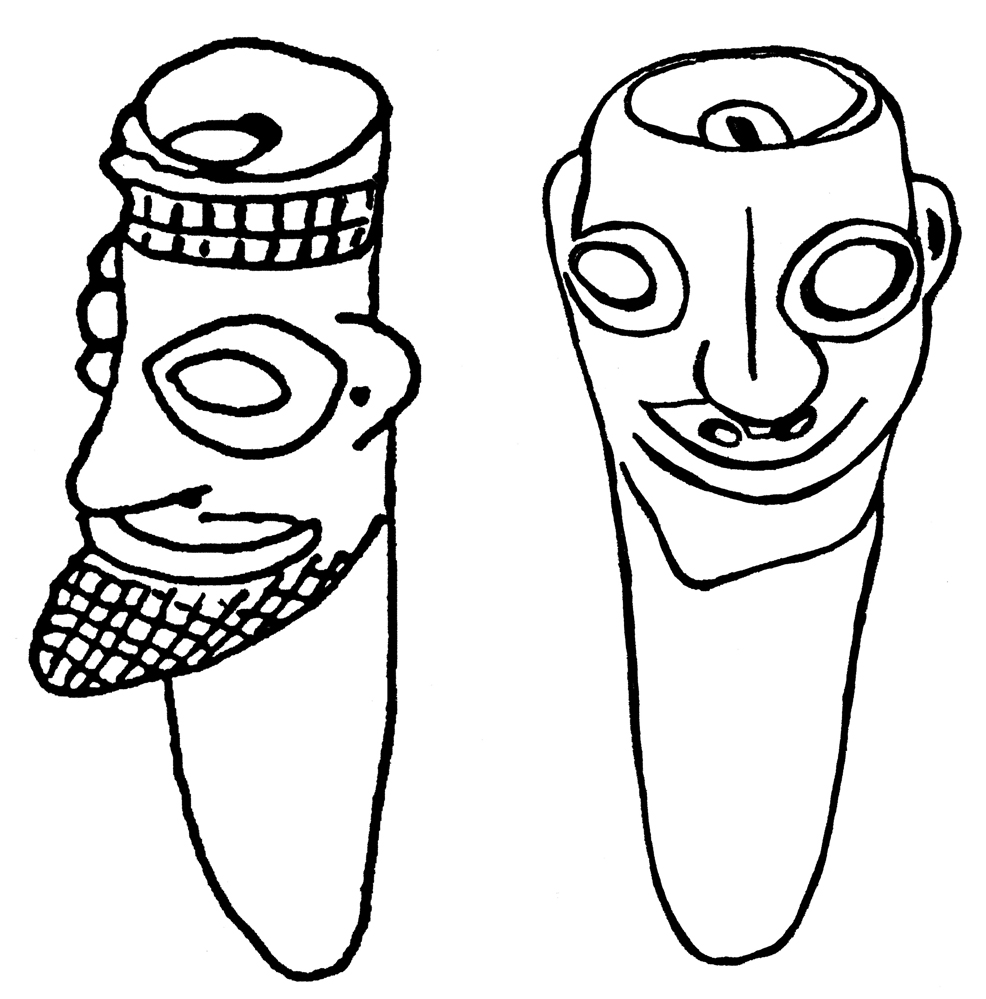 |
|
Fig. 1. Anthropomorphic coned Komaland figurines |
The most common type of Komaland terracotta consists of a head with a long conical neck or body (Fig. 1), which makes it possible to plant these figurines into the ground or into a mud-shrine. If we look for similar phenomena in the vicinity of the excavation area, there is a corresponding type of figurine in the present Lobi culture; it is made of wood and without the cavity in the skull (depicted in Meyer 1981:35, Fig. 59). Again, several other elements of the material culture of the Komaland terracottas are found, almost as expected, among the Lobi. Both cultures possess Janus representations, which nonetheless do not resemble each other very much. It is the same with images of anthropomorphic one-footed figurines, of which Meyer depicts a Lobi metal pendant (1981:169, Fig. 232). Calabash helmets, disc and moon-shaped chest pendants, leg cuffs and twisted iron bangles belong to the repertoire of both cultures but also to that of many other West African societies. As will be demonstrated in the following chapter about the Gan, a particular type of leg amulet occurs on some Komaland figurines and a similar type of amulet is still worn by Lobi women of today (cf. Fig. 2).
Kankpeyeng and Nkumbaan believe that the closest ethnographically analogous culture to that of the Komaland terracottas may be the Lobi of Northern Ghana (2008:99). In their publication from 2009, they mention the Bulsa in their considerations when they write that, "some contemporary societies in northern Ghana, such as the Lobi and Bulsa, also possess similar artefacts as figurines" (2009:200).
A detailed comparison of other relevant elements of the Lobi and Komaland material cultures using, for example, the works of Henri Labouret (1931), Piet Meyer (1981) and Klaus Schneider (1990) is still pending.
Although the great geographical distance between Komaland and the Lobi tribal territory in Burkina Faso is an argument against Lobi authorship of the terracottas, this objection is mitigated by their migratory history. Schneider comments that they once lived in what is now Northern Ghana, and probably towards the end of the 18th century they migrated from there to Burkina Faso (1990:27
S28). According to Père, there is evidence that the Lobi passed over the Mulun River (Black Volta) ten generations ago, and she calculates the date of the first crossing, based on supposing the length of one generation to be about 30 years, as occurring during the late 17th century.
5. The Gan or Kaaba (Burkina Faso)
Schneider, who published about and conducted field research among the Lobi of Burkina Faso, informed me by letter that the Gan material culture is similar to that of the Lobi, but their migratory background makes a connection to the Komaland culture more probable. The Gan, an ethnic group of about 6,000 members, live in the southwest of the Republic of Burkina Faso in the province of Poni. For about 400–500 years, Opiré has been the capital of their kingdom.
Using a rich amount of data, especially with regard to the society, history, religion and art of the Gan, Père (2004) assumes a relationship between the Gan of Burkina Faso and the creators of the Komaland terracottas. Her first method of collecting data consisted of showing photos from the work of Anquandah and van Ham (1985) as well as from a Swiss art gallery to a traditional sculptor of Gan figurines. Reflecting on their style, this informant related some of the Komaland figurines to Gan sculptures and other figurines to those of the Dagara, Lobi and Sisala (Père 2004:191). After these rather unsatisfactory results, Père changed her research method and looked for other evidence of bio-historical or archaeological relations to the Komaland culture (Père 2004:192). Specifically, she focused on the Gan religion’s symbolic objects, which take the form of anthropomorphic representations manifested either through freestanding figurines or as applied to metal trinkets. She asked ritual specialists about which Gan cult items and sculptures the specialists could relate to the photos of Komaland figurines (Père 2004:205, Plate V; 208, Plate VIII and X; 215, Plate XII). This method chosen by the researcher, however, must be viewed critically. In Plate V, for example, the photos of selected Gan and Komaland figurines show a certain resemblance to one another. However, the Komaland statuettes represent Janus figurines (though this is difficult to see in the photos), and so, therefore, they differ in one important regard to the depicted Gan figurine and, as such, are not suited for the comparison. Plate XIII depicts a Komaland Janus and a one-legged figurine. According to the interpretation of Père’s informants, this means that the initiation of a diviner has not yet been completed. In order to apply this interpretation to the Komaland culture, some preconditions must be assumed, namely the existence of diviners, their initiation and a divinatory technique which uses symbolic figurines.
In my own attempts to establish a correlation between the two cultures, I will try to compare the detailed descriptions of Gan religion, art and history, as well as the photos in the works of Père, Bognolo and Maine Durieu (2005) with my own Komaland photo collection. I admit that the criticism levelled at Père’s methods may also, to a certain degree, apply to my own method of comparing elements of Komaland figurines to those of other living or extinct cultures, because a photo can show a terracotta figurine from only one perspective.
5.1 Material Culture
A comparison of Komaland material culture with articles of ritual or secular use from the Gan reveals many parallels. However, the presence of these objects is not restricted to the two cultures concerned here, thus diminishing their value as relevant correlations. Ring or disc-shaped pendants, often with their centres being marked by a cowrie or a cylindrical or conical application, occur very frequently among the Komaland terracottas. While cowries are not found in the corresponding metal pendants of the Gan, there are a few published photos of Gan objects showing applications or knobs that are very similar to those of Komaland ring-pendants. Brazen leg cuffs were formerly used in many West African societies, for example, among the Bulsa, Lobi, Bobo, Senufo, Kasena and others. Remarkably there is a figurine in Bognolo’s book (2010:129, Fig. 124) which looks as if the cuff consists of several rings, one upon the other, and it is this form that can also be found on several Komaland figurines, especially on the legs of horse-riders (Fig. 2).
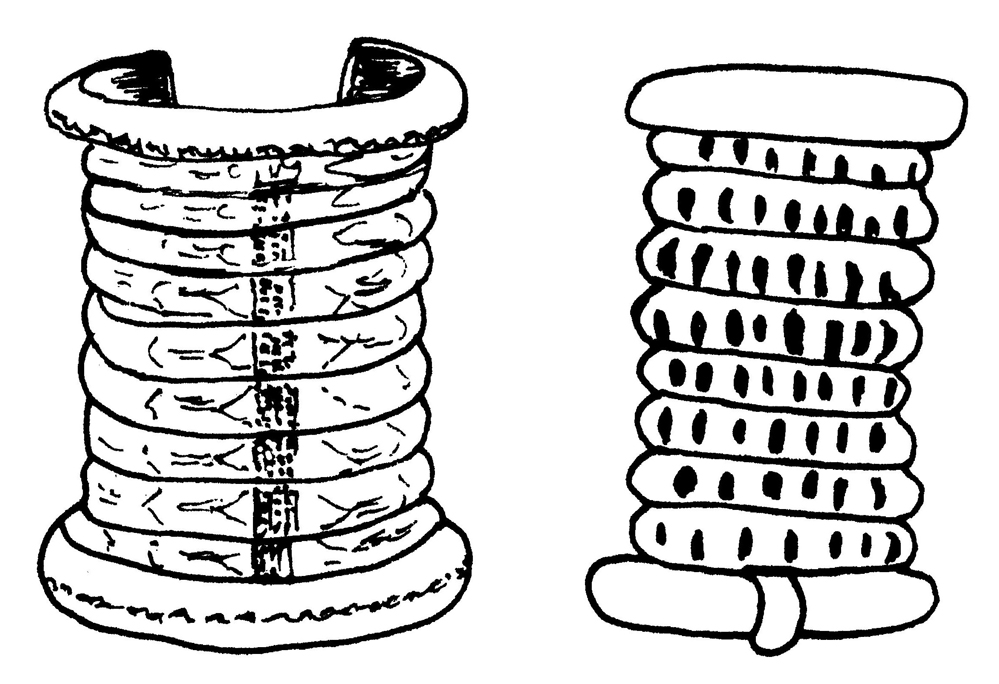 |
|
Fig. 2. Leg cuffs of the Gan (left) and from Komaland (right); Left drawing: based on a photo in Bognolo 2010:129, Fig. 124 |
Almost all musical instruments (e.g. conical, cylindrical and hourglass drums as well as gourd rattles) represented as independent instruments or with anthropomorphic Komaland figurines are found among the contemporary Gan as well as in many other West African ethnic groups. While most of the previously-mentioned objects have little value in establishing a close affinity between the two cultures concerned, this does not apply to a particular type of leg amulet worn only by Lobi and Gan women and which consists of an approximately 30-centimetre-long (wavy or straight) band of iron or bronze (Endnote 2), which is fastened to the leg with two cords or straps below the knee and around the ankle (Fig. 3). According to Bognolo (2010:110), this amulet protects the wearer against the guinea worm disease, which they believe is caused by a supernatural being. Bognolo, referring to the Gan (2010:110), and Fisher, referring to the Lobi (1988:128), depict serpentine iron amulets whereas four Komaland terracottas in my collection of photos sport straight ones. The straight type, similar to the one worn by the Komaland terracottas, is probably always cast in bronze among the Gan and has the head of its serpentine shape positioned near the ankle (Bognolo 2010:110).
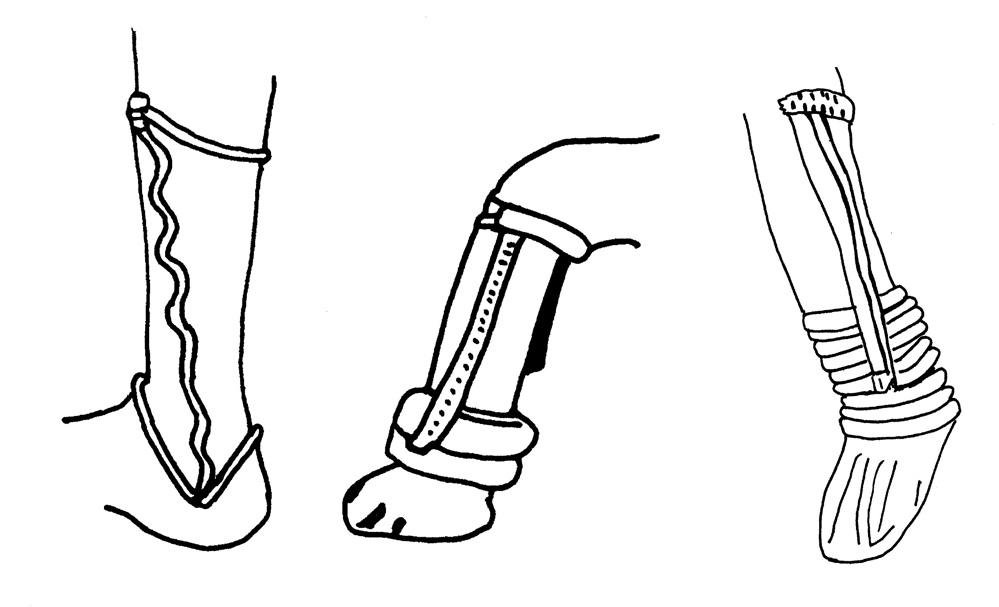 |
|
Fig. 3. Leg amulets of the Gan (left) and from Komaland (others) |
5.2 Anthropomorphic Figurines
Often, anthropomorphic figurines of two cultures provide clearer and more convincing arguments for their cultural affinity when they exhibit features that are rare or absent altogether in other ethnic groups of West Africa. However, in this regard a comparison between the Komaland culture and other cultures concerning body postures is not very productive. A sitting position with hands on the knees seems, in the cultures concerned here and in many other cultures, adequate for the presentation of a dignitary. But there are several differences between the very large termite-clay figurines of the royal Gan family and the small fired figurines of the Komaland culture. Specifically, the arms of the former are straight and usually the ancestor is depicted sitting directly on the floor (Père 2004:221) while the latter are often depicted with their arms angled and sitting on a round or square stool.
After the discoveries in Yikpabongo and their first evaluations, an anthropomorphic type of figurine with a hollow, bowl-like skull (Fig. 1) attracted the attention of many Ghanaian and foreign experts. Inside the cavity there is a round and deep hole or slit surrounded by a thin rim, which was previously interpreted as tongue, cowrie or female genital organ. Such representations of long-necked heads with hollow skulls are believed to be unique to West Africa. Père, however, tried to compare them with corresponding types of Gan figurines possessing an anthropomorphic head with a hollow skull, often with a tongue but without a trunk and limbs (Père 2004:202).
From Gan
informants she received the following explanation: Spirits have, by nature, an
immense knowledge about all things, but they cannot convey this knowledge to
human beings because they are unable to speak. The spirit finds a mediator in
the kperéé gbeeyé, an
extraordinary being, who, as he is not a spirit, can speak to certain initiated
human people. Both the spirit and the kperéé
gbeeyé, whom Père calls a «petit genie», lose their knowledge
completely after they have passed it on. For this reason, they are represented
with hollow skulls (2004:202). Unfortunately, Père only includes photos of
Komaland figurines with hollowed skulls and not of the corresponding Gan
figurines (Père 2004:205, Plate IV).
5.3 Janus Figurines
Anthropomorphic Janus figurines (in both the sense of figurines with one head and two faces or one body and multiple heads) occur in West Africa among several ethnic groups including the Lobi, Ibo, Igbo, Ikoi/Ekoi, Yoruba, Idoma, Dogon and Ashanti and can also be found among the old Nok terracottas. In the old Komaland culture, nearly all possible janiform variations were realized, including one head with two faces, one head with four faces, and two, three or four heads with two faces each. The Gan also have anthropomorphic, multi-headed figurines, which resemble the corresponding Komaland types in many respects. In one of Père’s illustrations, two heads grow out of a simple, broad body (2004:208, Plate XI). While each head of such a type always has two faces in the Komaland culture, this is obviously not the case in Père’s illustration of the Gan figurine. In any case, the anthropomorphic Janus representations of the Gan apparently do not display as manifold variations as the Komaland terracottas. Nevertheless, there is an adequate correlation between the numerous playfully arranged Komaland head types and the Gan artistic products, although the janiform Gan representations do not appear in anthropomorphic but rather in zoomorphic structures. To be precise, these sculptures exhibit multiplicities and combinations of python heads. Snakes with two, three, five or up to as many as 14 heads rank among the most impressive artistic creations of the Gan. The development of anthropomorphism in the janiform representations produced by their "kindred", the creators of the Komaland figurines, is not quite as extraordinary as it first appears because, for the Gan, the python is a symbol of a supernatural entity (Bognolo 2010:43). During this possible development of anthropomorphic Janus figurines of Komaland, it may have been that the triangular shape of the serpent's head had not been abandoned entirely (Fig. 4). Thus, the triangular head shape of these figurines, hitherto an enigma to all experts, finds some solid interpretation.
 |
|
Fig. 4. Janiform heads: Snake heads of the Gan (left) and anthropomorphic heads from Komaland (others); Left drawing (Gan) based on a photo in Bognolo 2010:136, Fig. 138
|
The very imaginative so-called ceramic discs, masterpieces of the Komaland culture in displaying the Janus motif, bear a striking resemblance to the zoomorphic bronze disks of the Gan (Fig. 5). While in my photo collection the maximum number of faces in a Komaland ceramic disk amounts to nine, Durieu (2005:44) published the photo of a bronze pendant with 13 snake heads arranged in a circular pattern, and in Bognolo’s book, there is a picture of a snake with 14 heads, also arranged in a circle (2010:136). Comparing these art objects of the two cultures, there is clearly a stronger anthropomorphism and a greater degree of abstraction and stylization in Komaland disks. At first glance, a viewer of the tart-like ceramic disc (Fig. 5, right) will perhaps not even recognize their janiform character, for the nine mouths together have only nine eyes and nine ear-holes (between the pairs of nose-holes), meaning that each complete face has to share eyes and ear-holes with the two neighbouring faces.
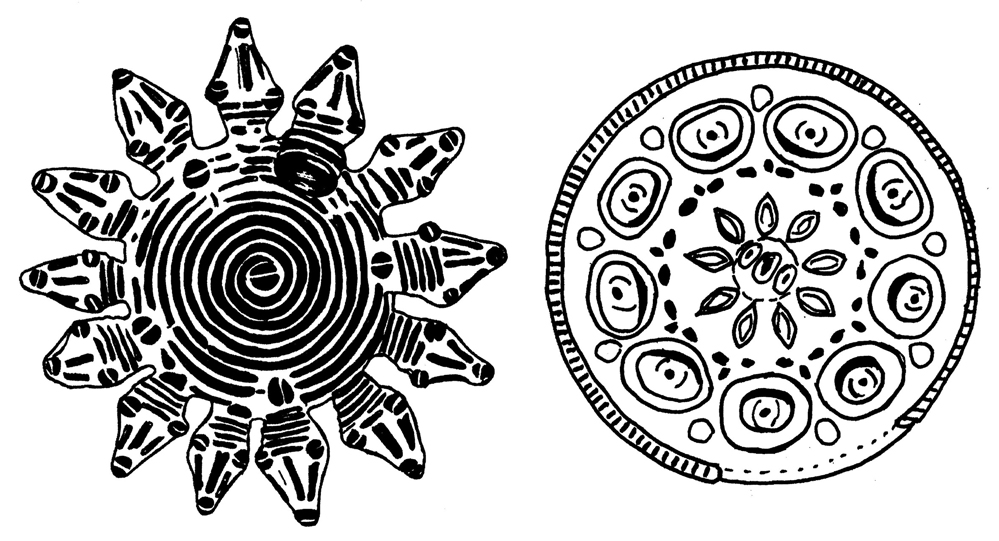 |
|
Fig. 5. Janus motifs in circular arrangements: Bronze snake amulet of the Gan (left) and Komaland ceramic disk (right)
|
5.4 Skull Cult
The most revealing correlation between the two cultures is probably not to be found in the material objects but in an important element of their death cults. In 2007 and 2010, Kankpeyeng and his team discovered a human skull detached from its torso during their excavations in Yikpabongo:
In January 2007, a single skull was recovered [...] without traces of any other human skeletal remains. The skull seems to have been placed facing the ground. In January 2010, a second skull was encountered on a different stone circle mound (YK 10-3) with the teeth removed and placed east of the skull and the jaw to the South. The long bones were placed beneath the jaw. This has been radiocarbon dated to Cal AD 1010 to 1170 (Kankpeyeng 2011:210).
Although this date is well ahead of the majority of previous dates attained by TL analyses, the new dating does not necessarily refer to the age of the settlement, as will be shown below.
Kankpeyeng's general assumptions about the possible origin of this kind of death cult can be applied to the Gan in particular:
The burial of the skull alone without any other or traces of remains or parts of the body is an unusual occurrence today in northern Ghana; but may be a ritual activity of a group not living in northern Ghana today or an abandoned tradition for several reasons, including migrations. Also, parallel ritual activities by some groups within West Africa may provide clues as to its meaning (2008:100).
It is most important for the argument here that this ritual practice was also performed previously by the Gan. According to sources in ethnographic literature, both the heads of deceased kings and of albinos were separated from the trunk. The skulls of albinos, beheaded specifically for this purpose on a golden stool, were used as a "cushion" or headrest for the deceased king (Bognolo 2019:58). According to Bognolo, albinos were considered to be water spirits and their sacrifice continued until the 10th Gan king, Ìkhumè-Sisa, an albino himself, forbid the slaughtering and substituted it with the sacrifice of a donkey (2010:58). The function of the skull cannot be restricted to providing a kind of headrest for the deceased king. Rather, he should also benefit from the slain albino’s kh
